Getting to Net-Zero Production: Part IV
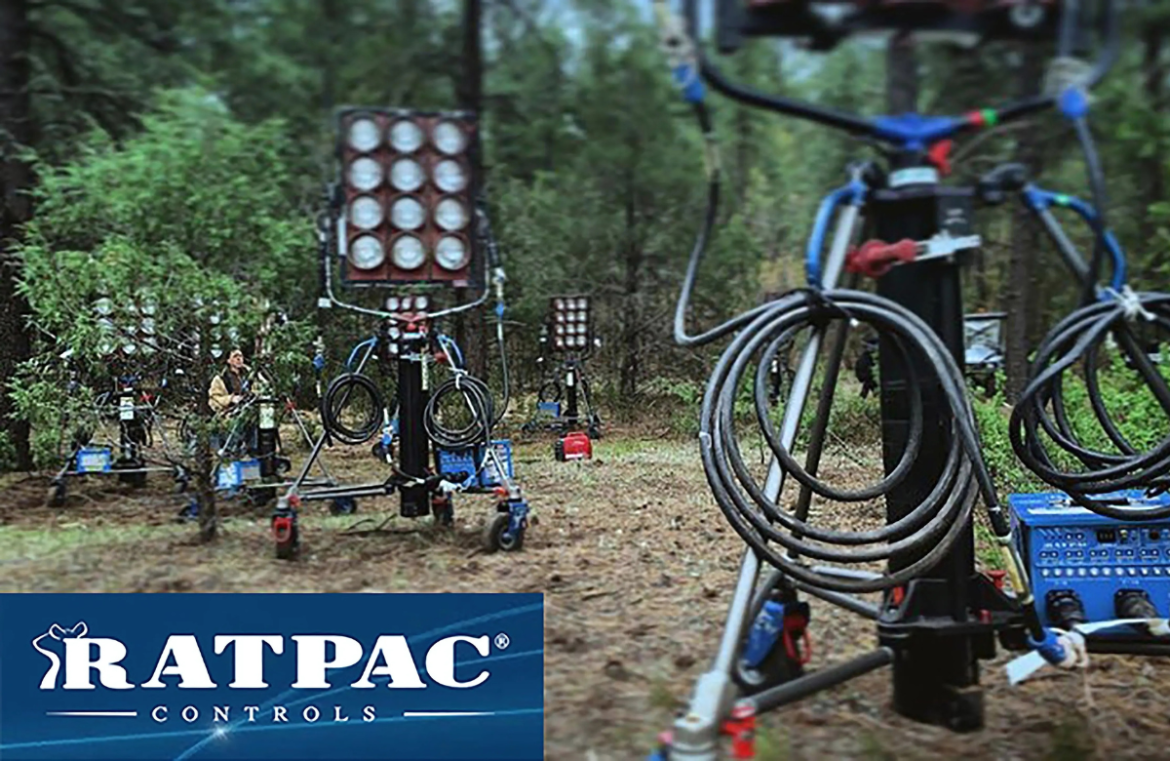
The introduction of mobile Battery Energy Storage Systems (BESS) has led to a paradigm shift in how power is sourced, distributed, and managed on movie sets and in live events. For example, in part one of this series (18 Sep 2024), we discovered that it is possible to get to net-zero production with mobile BESSs that can be paralleled to increase capacity and runtime. In part two of this series (17 Mar 2025), we discovered that the “hard” power of BESSs eliminates the need to isolate non-linear loads on separate power sources – greatly reducing the number of generators required. In this part we will look at whether just any mobile BESS will serve our purposes, or if a certain type is required.
BESSs breakdown into two basic categories: those optimized for interacting with the utility grid (called grid-following inverters) and those optimized for forming micro-grids (called grid-forming, or islanding, inverters). Early adopters of this technology are discovering compatibility issues with BESSs optimized to interact with utility grids because to maintain synchronization and safety, they require a stable voltage reference. When BESSs optimized for grid-following applications operate in grid-forming mode they can struggle to form a stable micro-grid because of internal protection software.
To understand why that is the case, and subsequently which BESS’s are best suited to our needs, we must first understand a fundamental difference in how BESSs operate compared to diesel generators. BESSs only generate voltage when called upon by a load. They don’t ‘idle’ like a generator. And don’t produce power whether there is a load consuming it or not. When there is no load, a BESS is chemically inert. It only converts stored chemical energy to electrical energy upon demand by a load. This difference has a significant impact when it comes to dimming incandescent lamps. To understand what makes legacy dimmers and state of the art inverters incompatible, let’s review how each works.
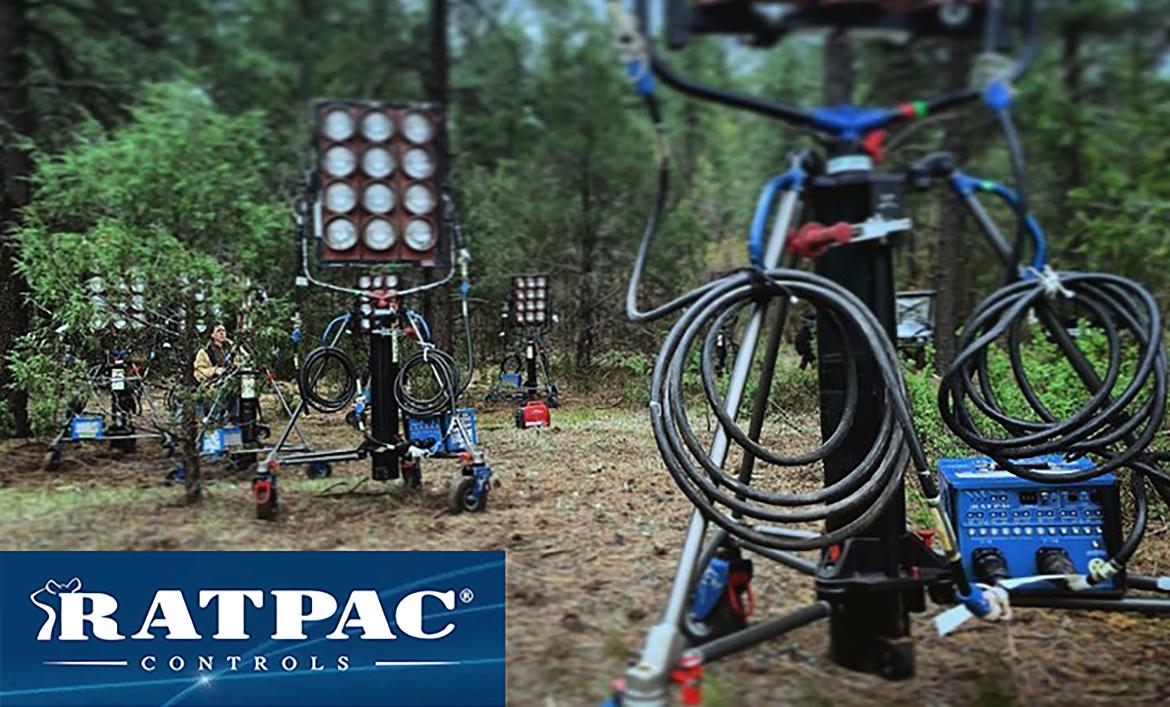
How Dimmers Work
There are several technologies used to dim incandescent lamps, each with its own characteristics and impact on power sources. Resistive dimmers, commonly called Variacs, use a variable autotransformer to adjust voltage to the lamp. SCR (Silicon-Controlled Rectifier) dimmers use solid-state relays (SSRs) to switch the lamp on during part of each AC half cycle. IGBT (Insulated-Gate Bipolar Transistor) dimmers use high-speed transistors to switch the power waveform more cleanly than SCR dimmers. And PWM (Pulse Width Modulation) dimmers rapidly switch on and off at high frequencies to simulate dimmed voltage waveforms. Most dimmers found on movie sets, in theatres, and on festival stages, are legacy SCR dimmers that use solid-state relays (SSRs) to delay switching “on” to dim lamps. To understand the challenges to using these types of dimmers on grid-following inverters, it helps to contrast them to resistive dimmers, or Variacs.
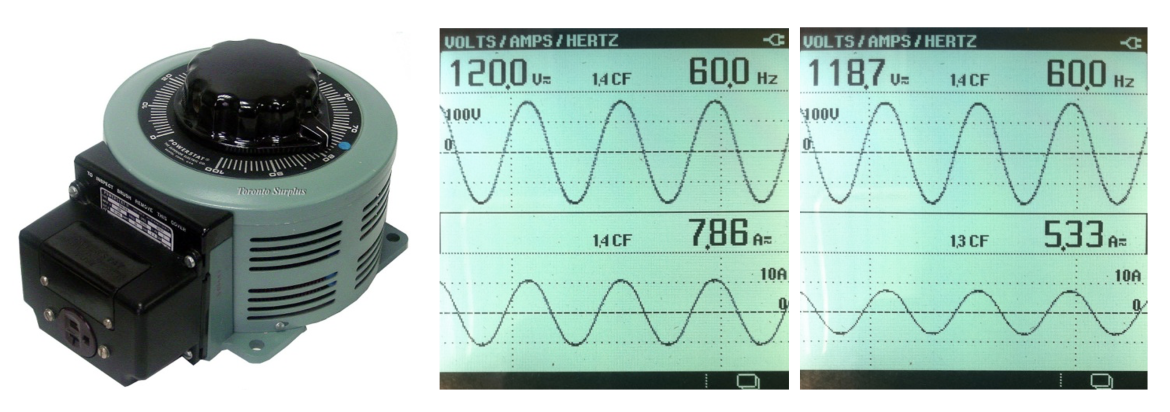
A Variac dims a lamp by reducing the voltage supplied to the filament. Here’s how it works: A Variac is a type of autotransformer with an adjustable tap that allows for precise voltage control. By rotating the Variac's control knob, the output voltage can be smoothly varied from nearly zero volts to full line voltage. As the voltage decreases, the filament in the incandescent lamp receives less power, producing less light. Since a Variac provides a continuous sine wave output (instead of chopping the waveform), there is no flickering or electrical noise. The downside to Variacs is that they are large and heavy due to the transformer core. Are less efficient compared to modern electronic dimmers. And limited to resistive loads (not suitable for LED or fluorescent lighting). The upside to Variacs is that current follows voltage in phase. As we reduce the output voltage current still follows voltage in phase, but just at a lower magnitude, so they always exhibit unity power factor.
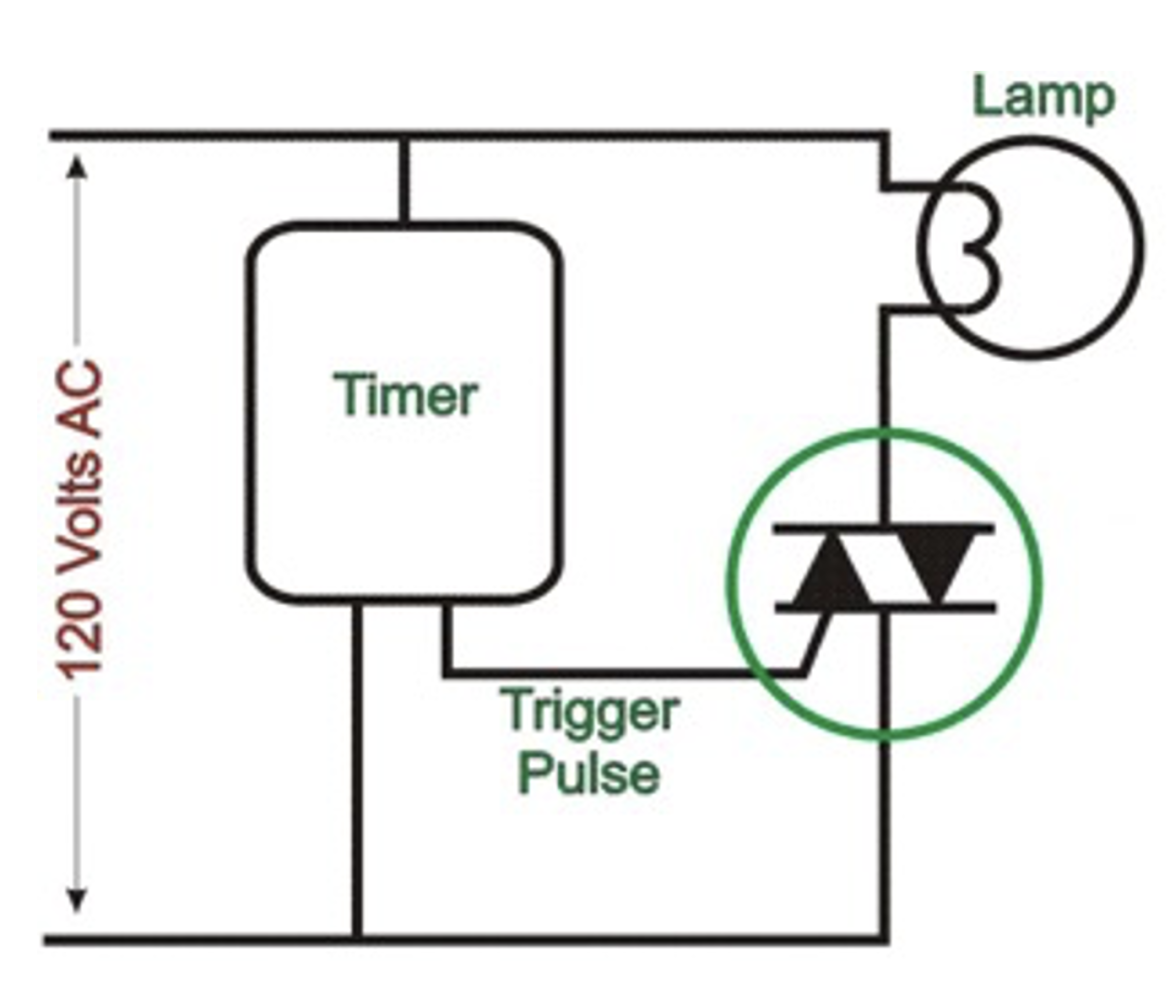
It is a whole different situation with dimmers that use solid-state relays (SSRs). An SSR consists of a pair of silicon-controlled rectifiers, or SCRs, and an opto-isolator for the control input. By connecting the SCRs in parallel but in opposite directions in a circuit, one can make a solid-state device, called a Triac, that regulates alternating current in both directions. A timing circuit is needed. That is the function of the controller card - the brains of the dimmer. The controller card detects the incoming control signal (DMX512 or Ethernet), decodes it, and produces trigger pulses in sync with the dimmer’s power phase to tell each SCR when to activate. One SCR turns on part way into the voltage (+) half cycle and remains on until the voltage and current falls to zero and crosses over the zero-volt crossing. In the (-) half cycle, the polarity of the power line reverses, and the process repeats with the second SCR. The net result is a “chopped” current waveform like that pictured below in Figure 4. If the timing of the turn-on is varied from zero to 100% of the half-cycle, the output power to the load varies from zero to full.
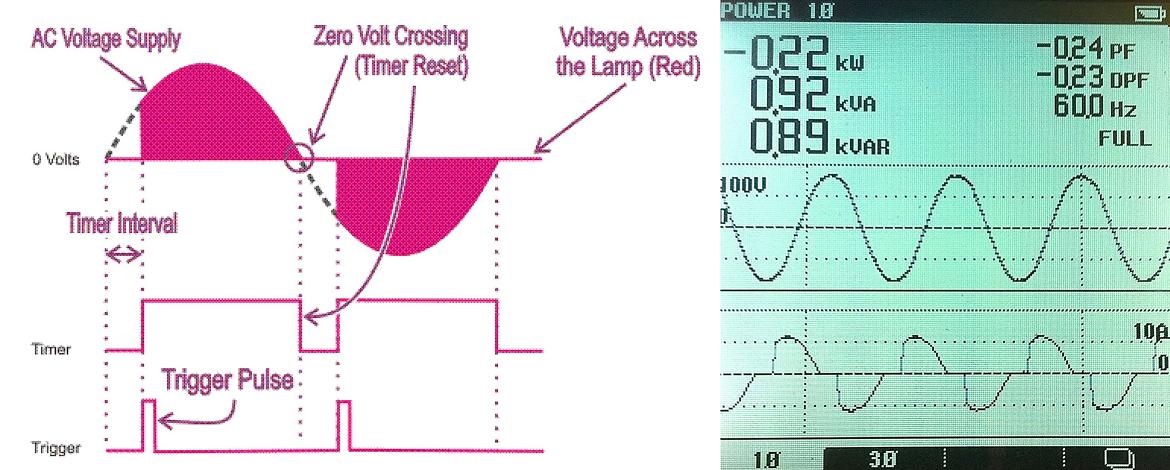
For example, as depicted in the illustrations above and below, if the duty cycle is long the lamp is brighter. If the duty cycle is decreased the lamp gets dimmer.
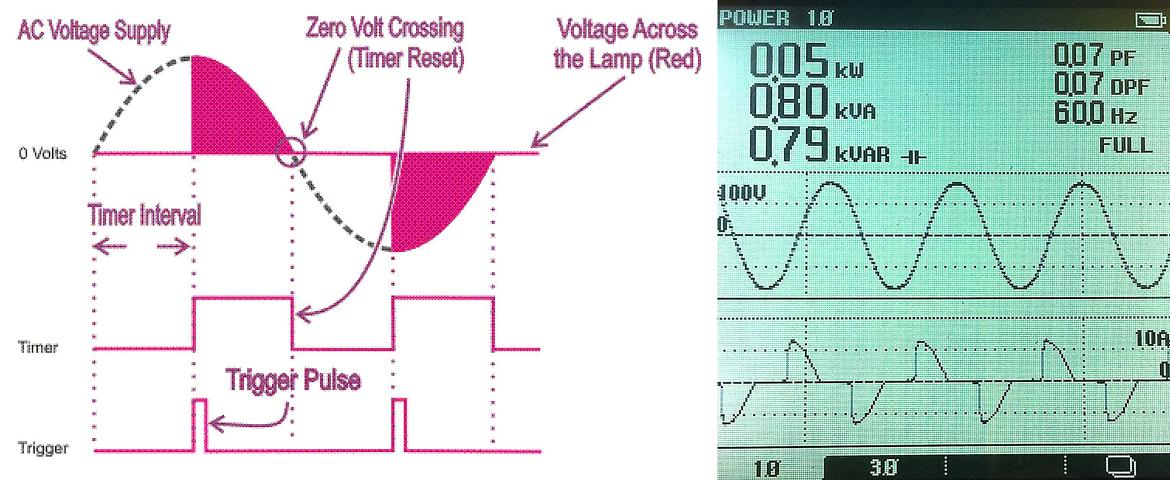
In effect, the duration of the timer within the half cycle of the sine wave determines the brightness of the lamp. Rather than increasing or decreasing voltage (the amplitude of the AC sine wave) as a Variac does, a SCR dimmer increases and decreases power by regulating the duty cycle, the on/off time, chopping up the sine wave as shown here.
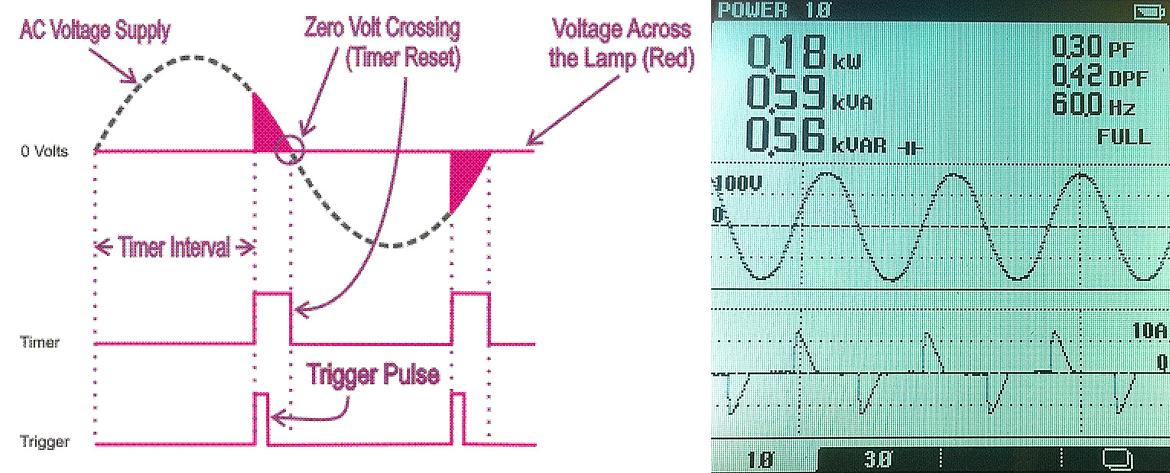
This is known as Forward Phase-Control (FPC) dimming because it chops the front part of the voltage waveform. It is also called leading edge dimming (LED). To avoid confusion with LED lights, I will refer to it as Forward Phase-Control, or FPC, dimming. To summarize, FPC dimming is a type of phase control where the turn on at each half cycle is delayed from the zero-crossing point so that the first voltage presented to the load after the zero crossing is the rising or “leading” edge of the voltage waveform.
How Inverters Differ from Diesel Generators
The inverters of BESSs operate very differently than diesel generators. Diesel generators shape the waveform of their voltage output through rotor excitation (magnitude), governor-controlled engine speed (frequency) and the design and construction of the alternator (waveform). How the design and construction of the alternator shapes the voltage waveform is through its “winding pitch”.
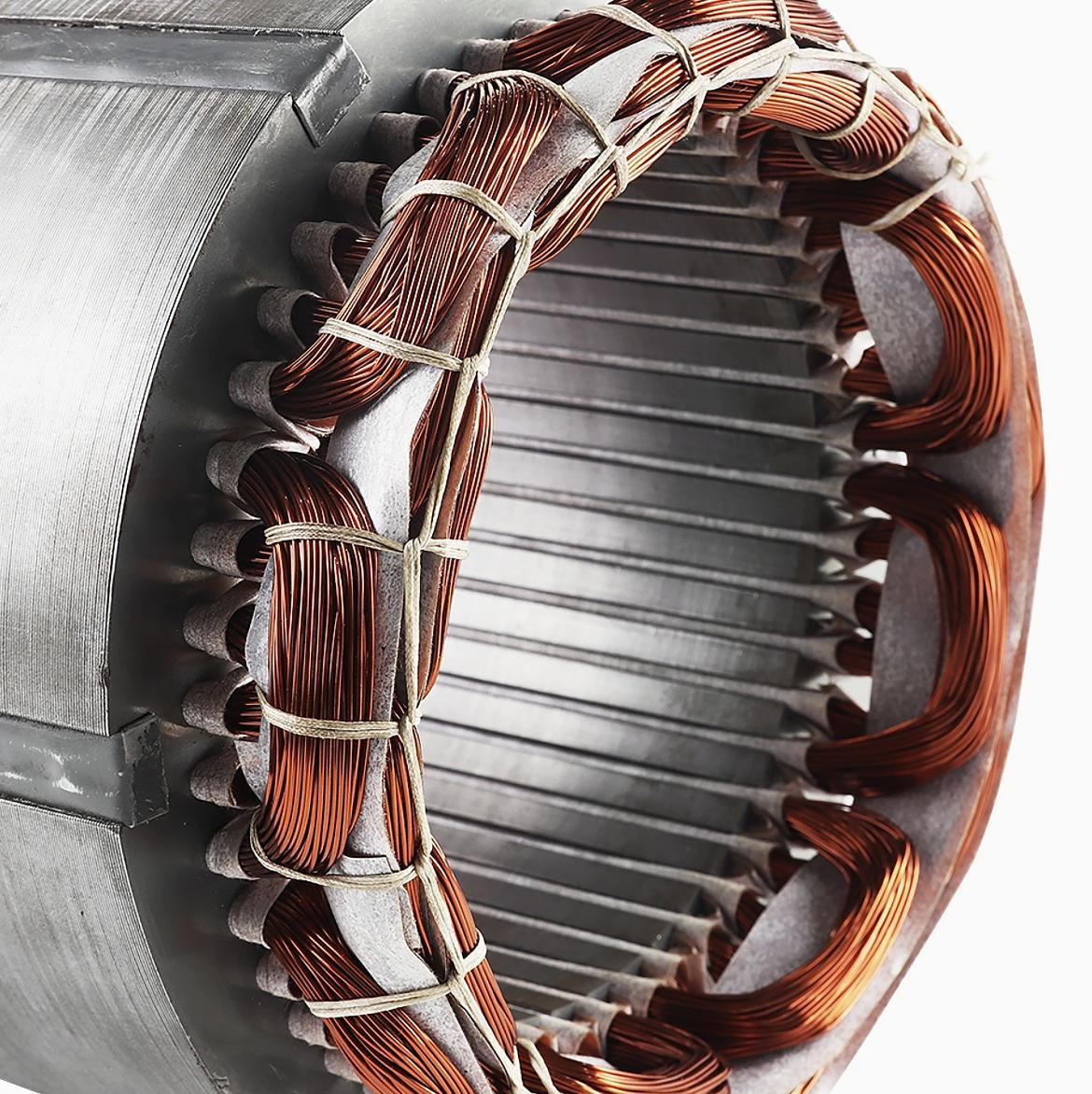
The copper wire in the stator of diesel generators is arranged in coils. The "pitch" of these coils refers to the spatial arrangement and the number of coils used. A key element here is the number of winding slots enclosed by each coil of the stator (Figure 7) to the number of winding slots per generator pole. Figure 8 below illustrates a full pitch winding. Here we have a 4-pole alternator with a 48-slot stator. In this generator one pole spans twelve slots.
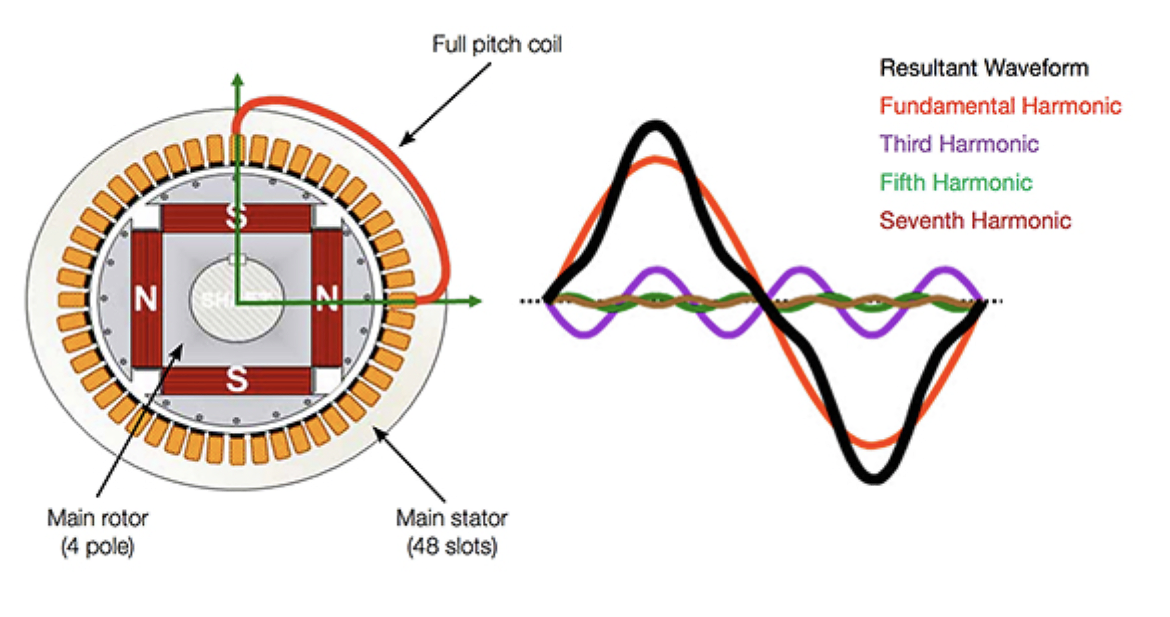
While aiming for a pure sine wave, diesel generators produce some degree of waveform distortion measured by its total harmonic distortion (THD). While slight (less than 3%), the waveform of diesel generators is distorted none-the-less. By using fractional pitch windings, generators can reduce or eliminate certain harmonic distortions, leading to a more sinusoidal voltage waveform. Fractional pitch windings, like 2/3 or 5/6, are commonly used to reduce or eliminate specific harmonic distortion. This is because fractional pitch windings reduce the "spatial harmonics" of the magnetic field, leading to a more sinusoidal induced voltage. For example, our show power generators use a 2/3 pitch winding (Figure 9) to eliminate the third harmonics generated by full pitch windings (Figure 8) which can cause issues like heating losses. While winding pitch, or the physical spacing of the generator's coils, can significantly improve the voltage waveform – making it more sinusoidal – it is baked into the generator and cannot be changed.
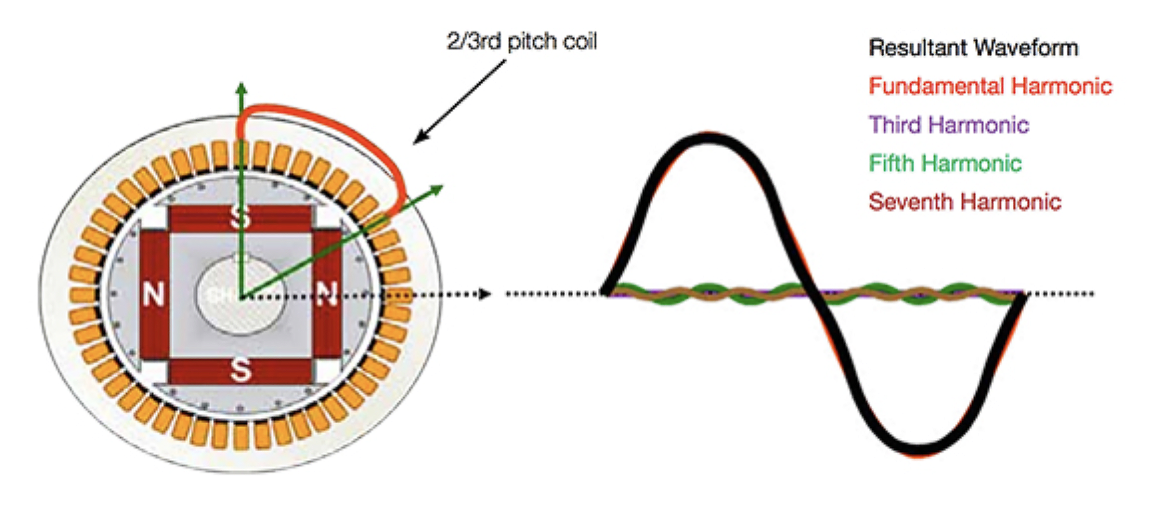
In contrast, a BESS inverter uses power electronics to convert the DC from batteries to AC by rapidly switching MOSFETs or IGBTs. By varying the switching frequency and the duration of the “on” and “off” states of these switches, the output inverter creates a series of voltage pulses. The width of these pulses, known as the pulse width, is adjusted by pulse width modulation (PWM) software to construct a pure AC voltage sine wave.
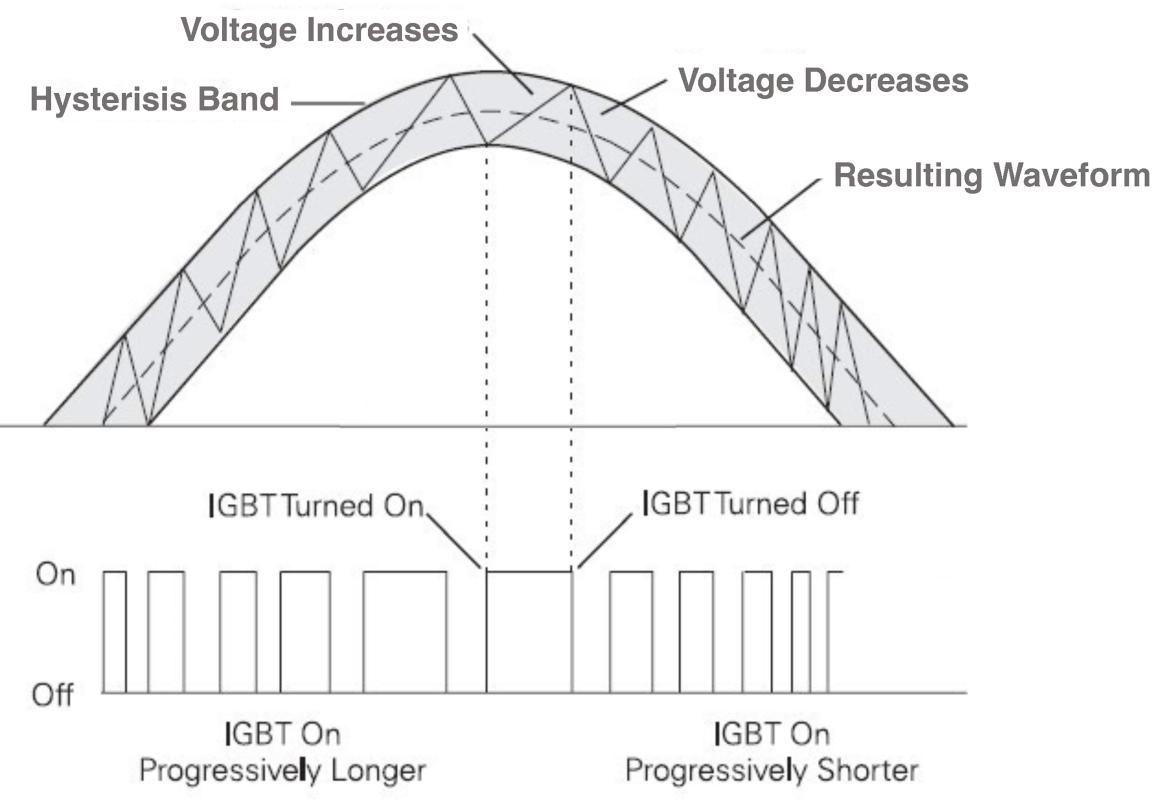
Software algorithms within the power control system (PCS) of the inverter monitor current and voltage in real-time. These PCS algorithms predict and respond to load conditions dynamically and actively modulate the waveform of the AC voltage output - adjusting its amplitude, crest factor, and phase angle.
Grid-following BESSs use this unique capability of inverters to conform its output voltage frequency, waveform, and phase angle to that of the grid so that it can assist the grid. To ensure safe operation during grid disturbances or failures, grid-following inverters have “anti-islanding” software that stops the conversion of DC to AC if the PCS doesn’t see expected voltage and current behavior – that way it doesn’t inadvertently back-feed the grid when there is a power outage. In contrast, the inverters of grid-forming BESSs construct a nearly perfect sine wave from scratch to supply clean power to its micro-grid. In both cases the PCS software shuts off absent a load.
How Inverters Recognize Loads:
An inverter’s PCS employs a sophisticated control system that goes beyond simple on/off detection. It instead uses a combination of current sensing, voltage sensing, and software algorithms to detect the presence of a load. The primary method is current sensing: When a load is switched on, it draws current, and the inverter’s current sensors detect the change. But an inverter’s PCS also monitors voltage levels. Changes in voltage can indicate the addition or change of a load. For example, a sudden drop in voltage may indicate a heavy load being applied. Advanced software algorithms analyze this information (current and voltage changes) to accurately detect, predict, and respond to varying load conditions.
To understand how such sophisticated control systems can be misled by simple solid-state relays requires drilling down a bit further: A primary factor that the PCSs of all inverters use in their analysis of voltage and current is when the AC voltage crosses zero (0V). This is called zero-crossing detection and is the crux of the problem.
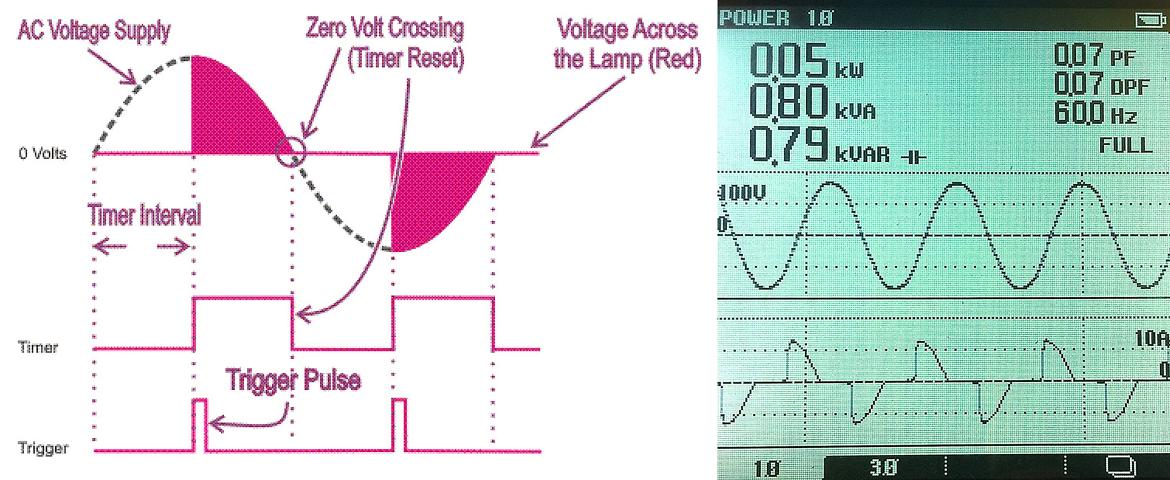
Since forward-phase dimmers chop the leading edge of the voltage waveform, as illustrated in Figure 10 above, 0V can persist for part or nearly all of the half cycle (depending on the dim level), and no current is generated until the SCR is triggered and passes voltage to the load. Since according to Ohm’s Law (V = I x R), when voltage is applied to a resistance, current will flow in a circuit, the “anti-islanding” software of grid following inverters interpret the absence of current immediately after the 0V cross-over threshold as an absence of load.
How Grid-Forming Inverters Handle Non-linear Loads
Grid forming inverters don’t generally have anti-islanding software, or if they do, it can be shut off. And since they are primarily used to form load connected microgrids, they incorporate sophisticated load-adaptive algorithms not necessarily found in grid-following inverters to accommodate non-linear loads such as LED lights, motors with variable frequency drives, and (wait for it) incandescent lamps dimmed with forward-phase SCR dimmers. Here’s how: Non-linear loads draw distorted current which can distort voltage, cause voltage sags, and pull current out of phase with voltage thereby reducing overall system power factor. The load-adaptive algorithms of grid-forming inverters dynamically adjust their output to counteract these effects. Here’s how the process works: Grid-forming inverters continuously sample the voltage and current waveforms using digital signal processors (DSPs). In this fashion they can detect not only changes in instantaneous power demand and phase imbalance, but also voltage waveform shape and harmonic content.
Since harmonics are nothing more than a means of mathematically modeling the distortion of a sinusoidal waveform, the load-adaptive algorithms of grid-forming inverters use measured voltage harmonics, and an inverter’s capability to construct voltage from scratch, to reconstruct the voltage waveform and cancel out load induced distortions. In this fashion, the inverter synthesizes a pure sine wave to supply clean voltage in the face of non-linear loads.
But that’s not all: The load-adaptive algorithms of grid-forming inverters can also modify the inverter’s output impedance to improve voltage stability under fluctuating demand. For example, when a high-inrush load (like a 20k) is switched on, the inverter temporarily stiffens its impedance to reduce the voltage waveform distortion (voltage drop) the high inrush current causes on the soft power of diesel generators. Once the load stabilizes, impedance is relaxed to maintain efficiency. The load adaptive algorithms of grid-forming inverters also measure reactive power and adjust the inverter’s phase angle to lead or lag the current as needed, improving system power factor. This reduces I²R losses and improves utilization of stored energy.
In effect, the load-adaptive algorithms of grid-forming inverters act like intelligent digital filters and controllers that dynamically modify output waveforms, timing, and impedance in real-time in micro seconds. Unlike the baked-in static voltage waveform distortion compensation of diesel generators (stator “pitch factor”), grid-forming inverters dynamically compensate for harmonic distortion, improve voltage regulation, and ensure stable performance in the presence of non-linear or rapidly changing loads in real time, making BESS with grid-forming inverters much better suited for film sets, concerts, or off-grid microgrids than grid-following inverters.
If it’s not possible to use a grid-forming inverter, another solution is to use reverse-phase dimmers. Reverse-phase dimming, also known as trailing-edge dimming, cuts off the AC power waveform at the end (trailing edge) of each half-cycle.

Since voltage continues to build after crossing over the 0V threshold, the current PCS control algorithms look for will be generated and the PCS will generate voltage. The downside to this solution is that trailing-edge dimmers and the associated components (like MOSFETs) make them considerably more expensive than forward-phase dimmers. The circuitry required for reverse-phase dimmers is also more complex, and more likely to fail, than that of forward-phase dimmers. For these reasons, reverse-phase dimmers are generally much harder to find than legacy leading-edge dimmers, so it is better to start with a BESS optimized for grid-forming, rather than one optimized for grid-following.
